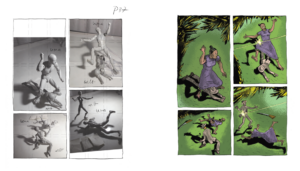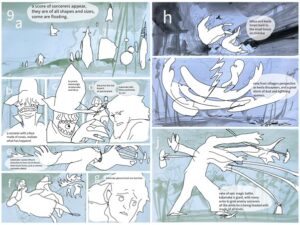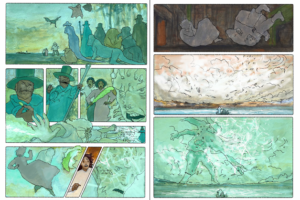Throughout this project, graphic novel artists Solomon Enos and Simon Grennan have been working on their adaptations of Robert Louis Stevenson’s Island Nights’ Entertainments. Though both have worked closely during the project, visiting the same locations relevant to Stevenson’s life in Scotland and Samoa, their approaches to the adaptation process have been very different.

Grennan has used a metatextual frame device in ‘Shadow Play’, his adaptation of Stevenson’s ‘The Beach of Falasá’, so that the story playing out emulates a shadow puppet theatre. He used mannequins and small models of the characters to stage the action sequences throughout the story, as his initial draft of page 38 of ‘Shadow Play’ attests. In the final version, this creates a sense of perpetual movement and reactivity, highlighting Uma’s dominance and power.
Enos, meanwhile, focused initially on backgrounds, structure and colour schemes in his early drafts. This helped him work through the challenges of depicting the multiple temporalities and locations throughout ‘The Bottle Imp’ and ‘The Isle of Voices’. Character development came later, with his versions of Stevenson’s female characters, particularly, taking more and more prominence in his drafts.


By comparing earlier drafts to the finished pages, we begin to see the degree of artistic negotiation that takes place in the cyclical repertoires of the adaptation process. Only by repeatedly acting out the new scripts they’d both written for Stevenson’s characters to play – whether in the form of abstract storyboard, as in the case of Enos, or of Grennan’s literal manoeuvring of Uma and Wiltshire wooden figures – could Grennan and Enos create their exquisite reinterpretations of Stevenson’s Pacific fiction.



